Digital Marketing Strategies and Data Analysis Report on Netflix
VerifiedAdded on 2023/01/06
|6
|1495
|22
Report
AI Summary
This report provides a comprehensive overview of digital marketing, contrasting it with traditional marketing methods. It uses Netflix as a case study to illustrate key concepts such as customer touchpoints and the omnichannel customer journey. The report delves into the analysis of data derived from digital marketing activities, highlighting how companies can leverage this information to enhance their strategies, predict sales, and understand customer preferences. The report emphasizes the importance of digital marketing in today's business environment, showcasing its cost-effectiveness and effectiveness in reaching target audiences, ultimately leading to increased profitability and customer base expansion. The report concludes by underscoring the significance of adapting digital marketing strategies for sustained business growth and success.
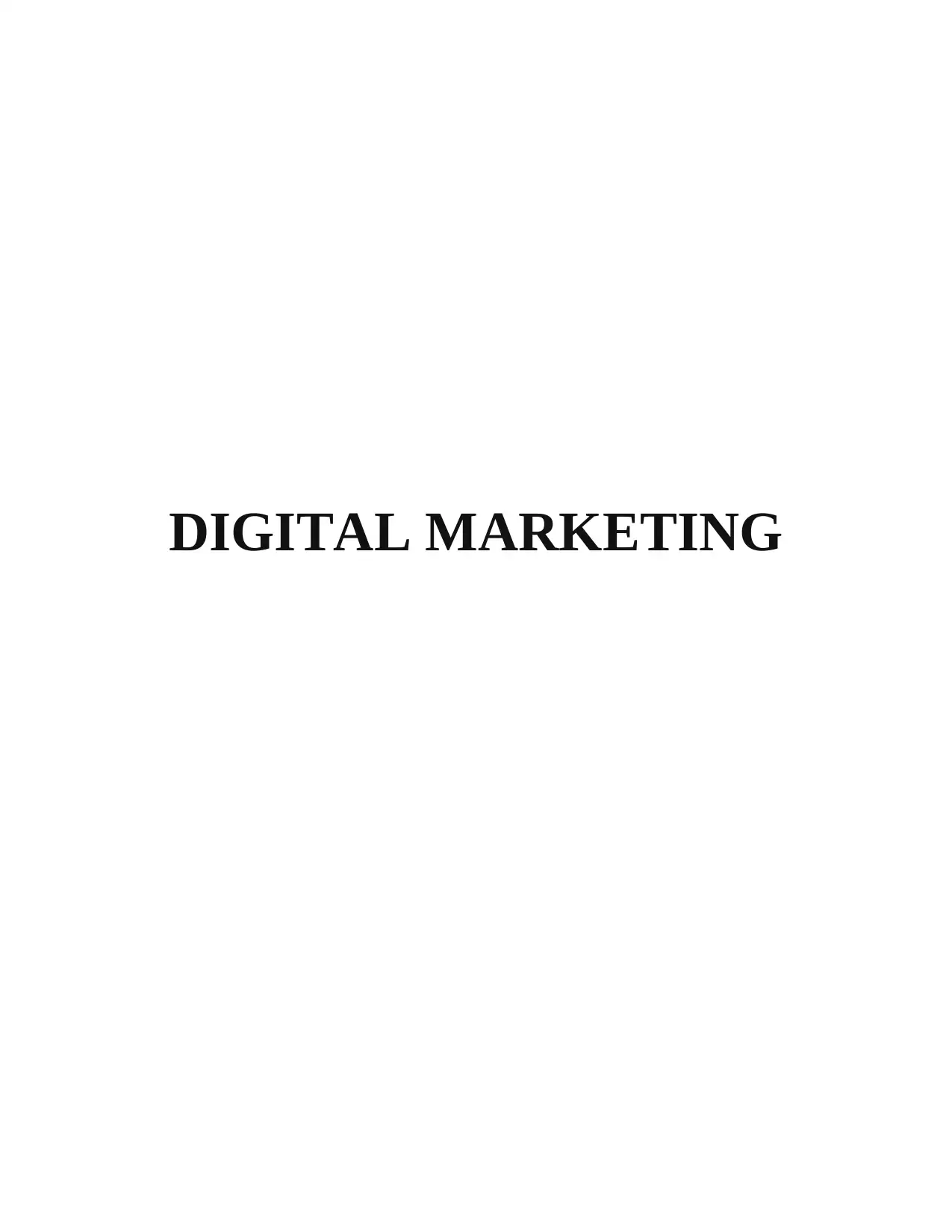
DIGITAL MARKETING
Paraphrase This Document
Need a fresh take? Get an instant paraphrase of this document with our AI Paraphraser
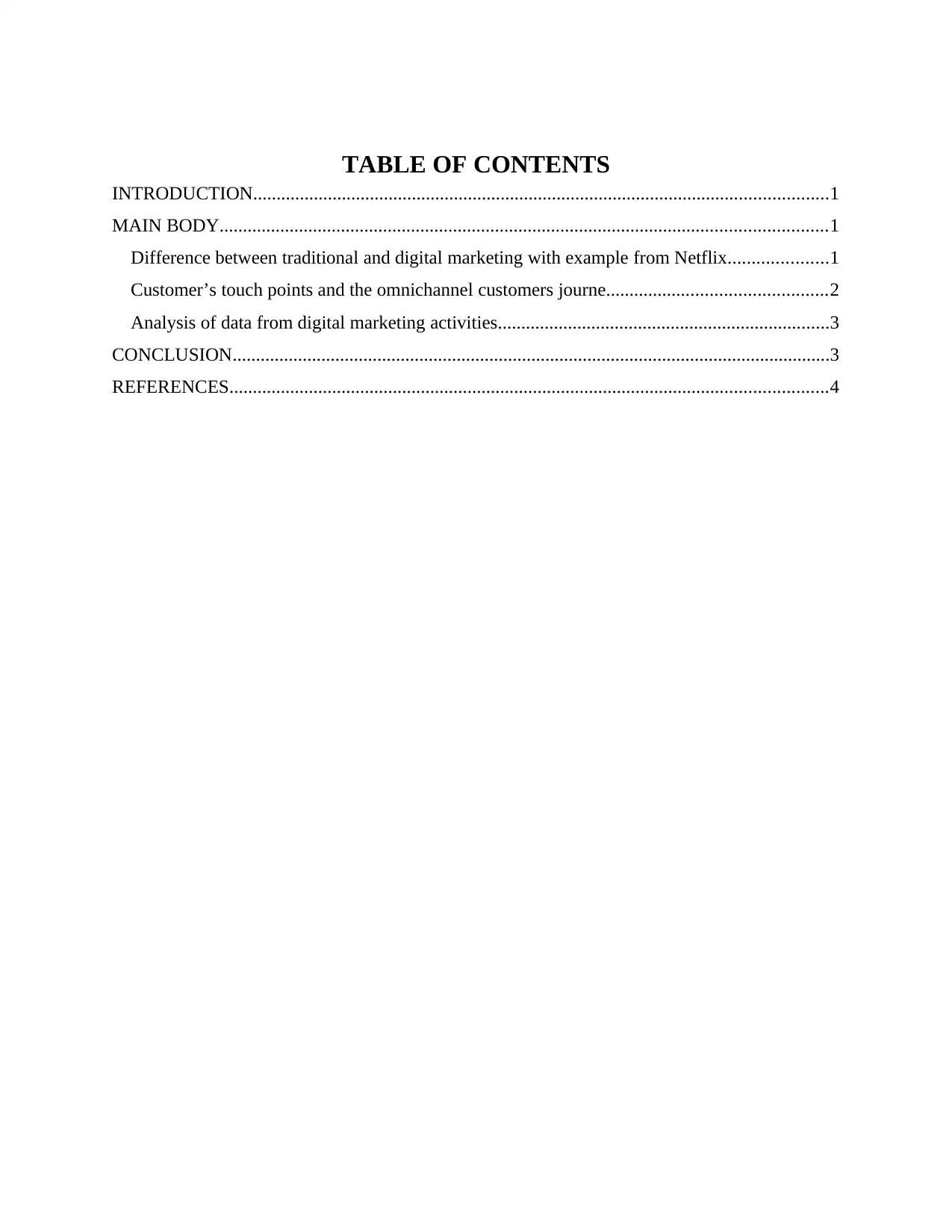
TABLE OF CONTENTS
INTRODUCTION...........................................................................................................................1
MAIN BODY..................................................................................................................................1
Difference between traditional and digital marketing with example from Netflix.....................1
Customer’s touch points and the omnichannel customers journe...............................................2
Analysis of data from digital marketing activities.......................................................................3
CONCLUSION................................................................................................................................3
REFERENCES................................................................................................................................4
INTRODUCTION...........................................................................................................................1
MAIN BODY..................................................................................................................................1
Difference between traditional and digital marketing with example from Netflix.....................1
Customer’s touch points and the omnichannel customers journe...............................................2
Analysis of data from digital marketing activities.......................................................................3
CONCLUSION................................................................................................................................3
REFERENCES................................................................................................................................4
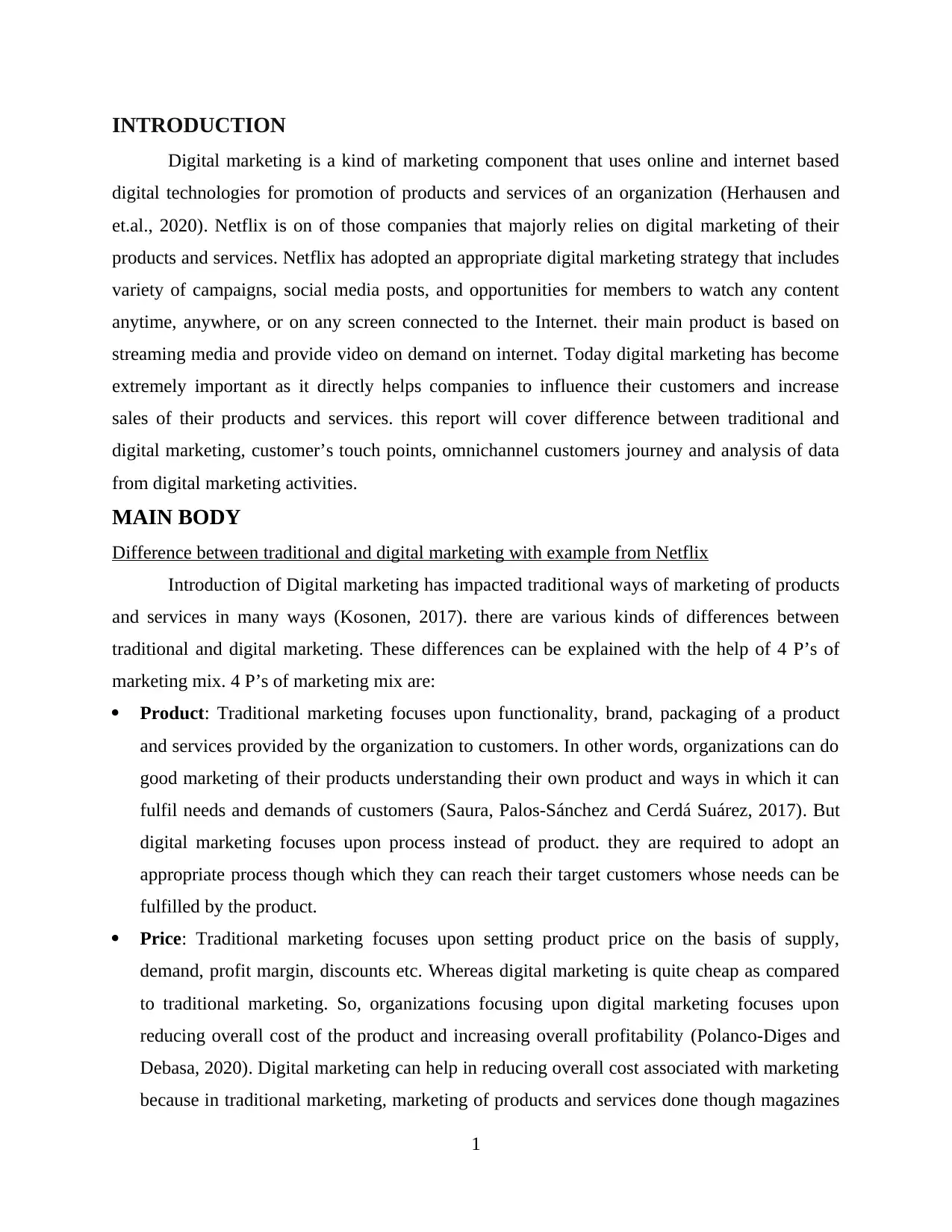
INTRODUCTION
Digital marketing is a kind of marketing component that uses online and internet based
digital technologies for promotion of products and services of an organization (Herhausen and
et.al., 2020). Netflix is on of those companies that majorly relies on digital marketing of their
products and services. Netflix has adopted an appropriate digital marketing strategy that includes
variety of campaigns, social media posts, and opportunities for members to watch any content
anytime, anywhere, or on any screen connected to the Internet. their main product is based on
streaming media and provide video on demand on internet. Today digital marketing has become
extremely important as it directly helps companies to influence their customers and increase
sales of their products and services. this report will cover difference between traditional and
digital marketing, customer’s touch points, omnichannel customers journey and analysis of data
from digital marketing activities.
MAIN BODY
Difference between traditional and digital marketing with example from Netflix
Introduction of Digital marketing has impacted traditional ways of marketing of products
and services in many ways (Kosonen, 2017). there are various kinds of differences between
traditional and digital marketing. These differences can be explained with the help of 4 P’s of
marketing mix. 4 P’s of marketing mix are:
Product: Traditional marketing focuses upon functionality, brand, packaging of a product
and services provided by the organization to customers. In other words, organizations can do
good marketing of their products understanding their own product and ways in which it can
fulfil needs and demands of customers (Saura, Palos-Sánchez and Cerdá Suárez, 2017). But
digital marketing focuses upon process instead of product. they are required to adopt an
appropriate process though which they can reach their target customers whose needs can be
fulfilled by the product.
Price: Traditional marketing focuses upon setting product price on the basis of supply,
demand, profit margin, discounts etc. Whereas digital marketing is quite cheap as compared
to traditional marketing. So, organizations focusing upon digital marketing focuses upon
reducing overall cost of the product and increasing overall profitability (Polanco-Diges and
Debasa, 2020). Digital marketing can help in reducing overall cost associated with marketing
because in traditional marketing, marketing of products and services done though magazines
1
Digital marketing is a kind of marketing component that uses online and internet based
digital technologies for promotion of products and services of an organization (Herhausen and
et.al., 2020). Netflix is on of those companies that majorly relies on digital marketing of their
products and services. Netflix has adopted an appropriate digital marketing strategy that includes
variety of campaigns, social media posts, and opportunities for members to watch any content
anytime, anywhere, or on any screen connected to the Internet. their main product is based on
streaming media and provide video on demand on internet. Today digital marketing has become
extremely important as it directly helps companies to influence their customers and increase
sales of their products and services. this report will cover difference between traditional and
digital marketing, customer’s touch points, omnichannel customers journey and analysis of data
from digital marketing activities.
MAIN BODY
Difference between traditional and digital marketing with example from Netflix
Introduction of Digital marketing has impacted traditional ways of marketing of products
and services in many ways (Kosonen, 2017). there are various kinds of differences between
traditional and digital marketing. These differences can be explained with the help of 4 P’s of
marketing mix. 4 P’s of marketing mix are:
Product: Traditional marketing focuses upon functionality, brand, packaging of a product
and services provided by the organization to customers. In other words, organizations can do
good marketing of their products understanding their own product and ways in which it can
fulfil needs and demands of customers (Saura, Palos-Sánchez and Cerdá Suárez, 2017). But
digital marketing focuses upon process instead of product. they are required to adopt an
appropriate process though which they can reach their target customers whose needs can be
fulfilled by the product.
Price: Traditional marketing focuses upon setting product price on the basis of supply,
demand, profit margin, discounts etc. Whereas digital marketing is quite cheap as compared
to traditional marketing. So, organizations focusing upon digital marketing focuses upon
reducing overall cost of the product and increasing overall profitability (Polanco-Diges and
Debasa, 2020). Digital marketing can help in reducing overall cost associated with marketing
because in traditional marketing, marketing of products and services done though magazines
1
⊘ This is a preview!⊘
Do you want full access?
Subscribe today to unlock all pages.

Trusted by 1+ million students worldwide
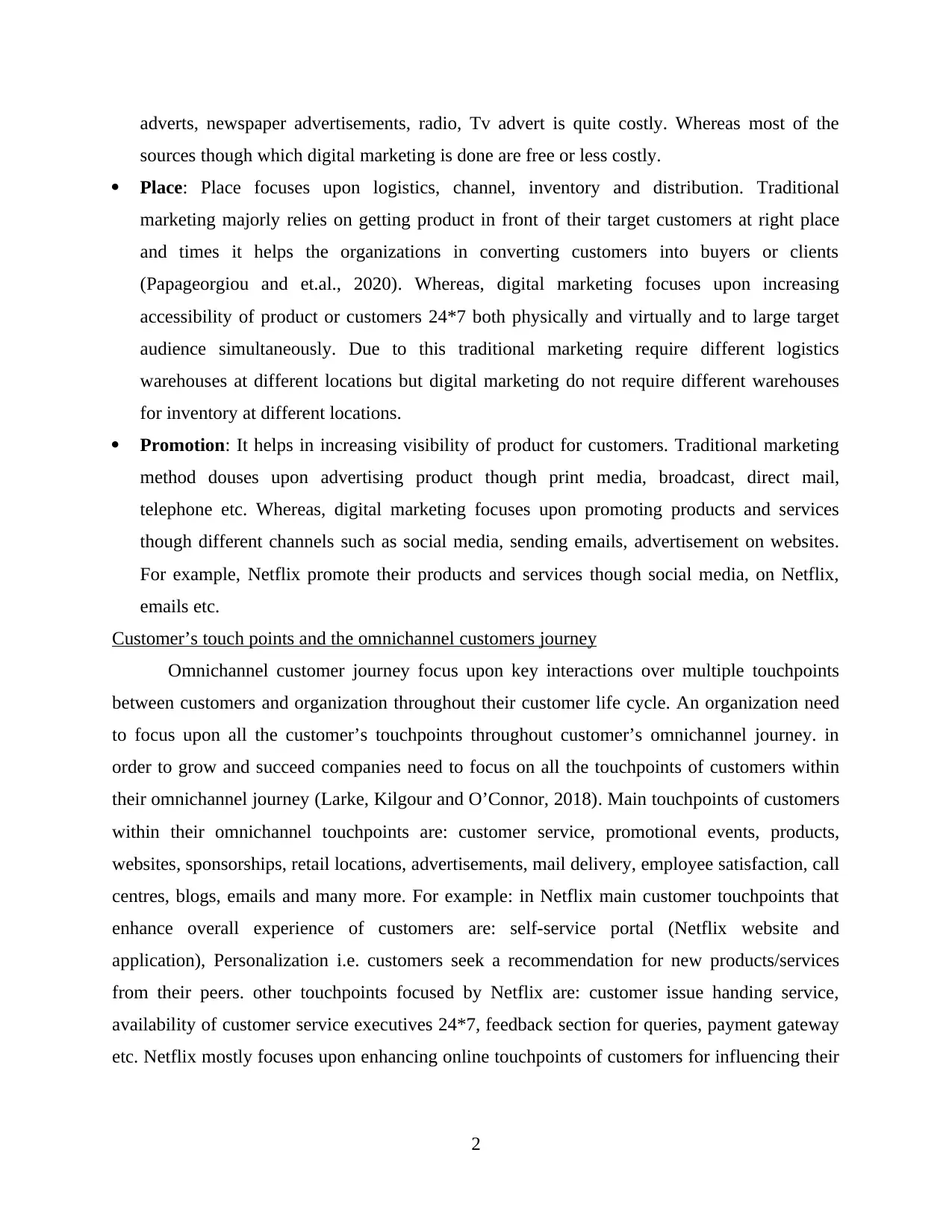
adverts, newspaper advertisements, radio, Tv advert is quite costly. Whereas most of the
sources though which digital marketing is done are free or less costly.
Place: Place focuses upon logistics, channel, inventory and distribution. Traditional
marketing majorly relies on getting product in front of their target customers at right place
and times it helps the organizations in converting customers into buyers or clients
(Papageorgiou and et.al., 2020). Whereas, digital marketing focuses upon increasing
accessibility of product or customers 24*7 both physically and virtually and to large target
audience simultaneously. Due to this traditional marketing require different logistics
warehouses at different locations but digital marketing do not require different warehouses
for inventory at different locations.
Promotion: It helps in increasing visibility of product for customers. Traditional marketing
method douses upon advertising product though print media, broadcast, direct mail,
telephone etc. Whereas, digital marketing focuses upon promoting products and services
though different channels such as social media, sending emails, advertisement on websites.
For example, Netflix promote their products and services though social media, on Netflix,
emails etc.
Customer’s touch points and the omnichannel customers journey
Omnichannel customer journey focus upon key interactions over multiple touchpoints
between customers and organization throughout their customer life cycle. An organization need
to focus upon all the customer’s touchpoints throughout customer’s omnichannel journey. in
order to grow and succeed companies need to focus on all the touchpoints of customers within
their omnichannel journey (Larke, Kilgour and O’Connor, 2018). Main touchpoints of customers
within their omnichannel touchpoints are: customer service, promotional events, products,
websites, sponsorships, retail locations, advertisements, mail delivery, employee satisfaction, call
centres, blogs, emails and many more. For example: in Netflix main customer touchpoints that
enhance overall experience of customers are: self-service portal (Netflix website and
application), Personalization i.e. customers seek a recommendation for new products/services
from their peers. other touchpoints focused by Netflix are: customer issue handing service,
availability of customer service executives 24*7, feedback section for queries, payment gateway
etc. Netflix mostly focuses upon enhancing online touchpoints of customers for influencing their
2
sources though which digital marketing is done are free or less costly.
Place: Place focuses upon logistics, channel, inventory and distribution. Traditional
marketing majorly relies on getting product in front of their target customers at right place
and times it helps the organizations in converting customers into buyers or clients
(Papageorgiou and et.al., 2020). Whereas, digital marketing focuses upon increasing
accessibility of product or customers 24*7 both physically and virtually and to large target
audience simultaneously. Due to this traditional marketing require different logistics
warehouses at different locations but digital marketing do not require different warehouses
for inventory at different locations.
Promotion: It helps in increasing visibility of product for customers. Traditional marketing
method douses upon advertising product though print media, broadcast, direct mail,
telephone etc. Whereas, digital marketing focuses upon promoting products and services
though different channels such as social media, sending emails, advertisement on websites.
For example, Netflix promote their products and services though social media, on Netflix,
emails etc.
Customer’s touch points and the omnichannel customers journey
Omnichannel customer journey focus upon key interactions over multiple touchpoints
between customers and organization throughout their customer life cycle. An organization need
to focus upon all the customer’s touchpoints throughout customer’s omnichannel journey. in
order to grow and succeed companies need to focus on all the touchpoints of customers within
their omnichannel journey (Larke, Kilgour and O’Connor, 2018). Main touchpoints of customers
within their omnichannel touchpoints are: customer service, promotional events, products,
websites, sponsorships, retail locations, advertisements, mail delivery, employee satisfaction, call
centres, blogs, emails and many more. For example: in Netflix main customer touchpoints that
enhance overall experience of customers are: self-service portal (Netflix website and
application), Personalization i.e. customers seek a recommendation for new products/services
from their peers. other touchpoints focused by Netflix are: customer issue handing service,
availability of customer service executives 24*7, feedback section for queries, payment gateway
etc. Netflix mostly focuses upon enhancing online touchpoints of customers for influencing their
2
Paraphrase This Document
Need a fresh take? Get an instant paraphrase of this document with our AI Paraphraser
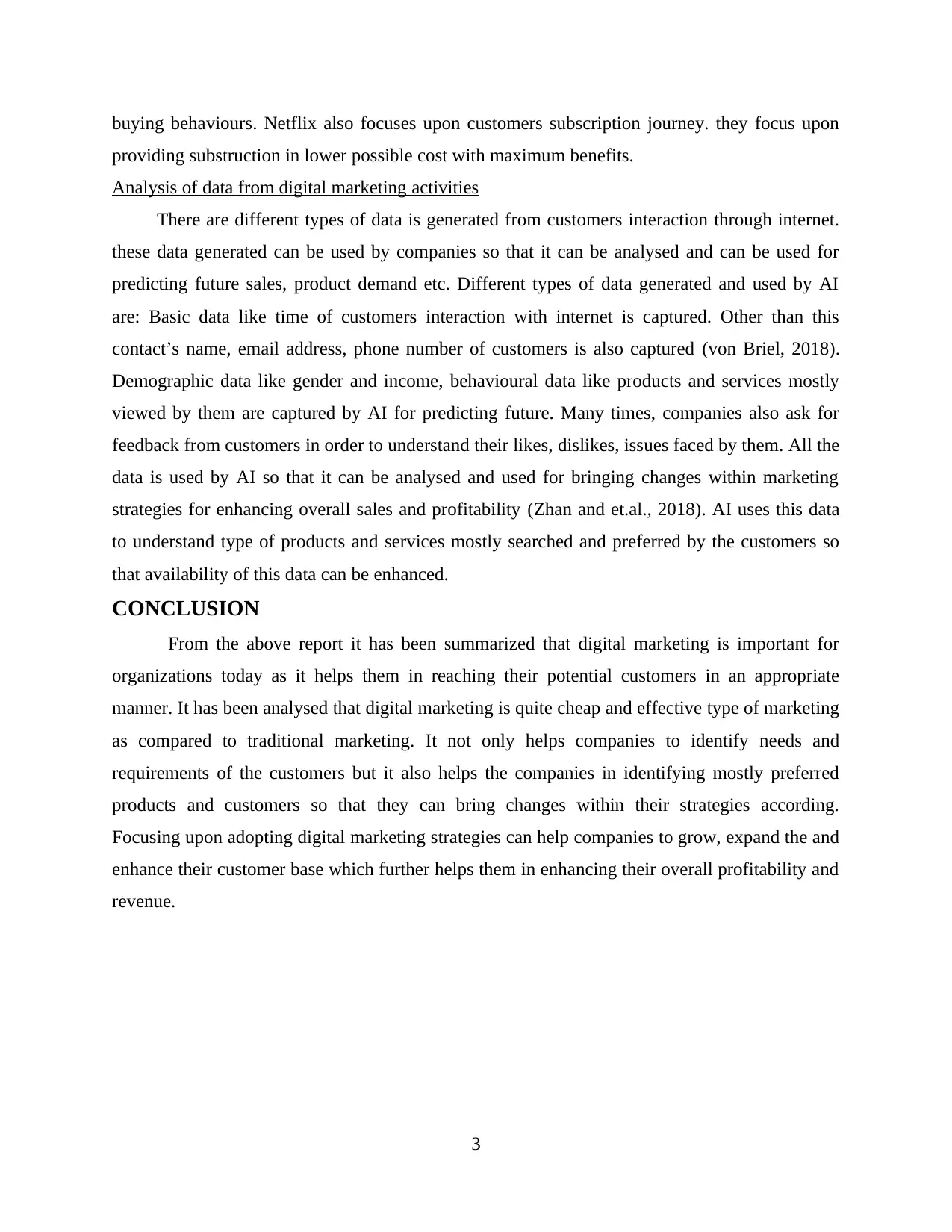
buying behaviours. Netflix also focuses upon customers subscription journey. they focus upon
providing substruction in lower possible cost with maximum benefits.
Analysis of data from digital marketing activities
There are different types of data is generated from customers interaction through internet.
these data generated can be used by companies so that it can be analysed and can be used for
predicting future sales, product demand etc. Different types of data generated and used by AI
are: Basic data like time of customers interaction with internet is captured. Other than this
contact’s name, email address, phone number of customers is also captured (von Briel, 2018).
Demographic data like gender and income, behavioural data like products and services mostly
viewed by them are captured by AI for predicting future. Many times, companies also ask for
feedback from customers in order to understand their likes, dislikes, issues faced by them. All the
data is used by AI so that it can be analysed and used for bringing changes within marketing
strategies for enhancing overall sales and profitability (Zhan and et.al., 2018). AI uses this data
to understand type of products and services mostly searched and preferred by the customers so
that availability of this data can be enhanced.
CONCLUSION
From the above report it has been summarized that digital marketing is important for
organizations today as it helps them in reaching their potential customers in an appropriate
manner. It has been analysed that digital marketing is quite cheap and effective type of marketing
as compared to traditional marketing. It not only helps companies to identify needs and
requirements of the customers but it also helps the companies in identifying mostly preferred
products and customers so that they can bring changes within their strategies according.
Focusing upon adopting digital marketing strategies can help companies to grow, expand the and
enhance their customer base which further helps them in enhancing their overall profitability and
revenue.
3
providing substruction in lower possible cost with maximum benefits.
Analysis of data from digital marketing activities
There are different types of data is generated from customers interaction through internet.
these data generated can be used by companies so that it can be analysed and can be used for
predicting future sales, product demand etc. Different types of data generated and used by AI
are: Basic data like time of customers interaction with internet is captured. Other than this
contact’s name, email address, phone number of customers is also captured (von Briel, 2018).
Demographic data like gender and income, behavioural data like products and services mostly
viewed by them are captured by AI for predicting future. Many times, companies also ask for
feedback from customers in order to understand their likes, dislikes, issues faced by them. All the
data is used by AI so that it can be analysed and used for bringing changes within marketing
strategies for enhancing overall sales and profitability (Zhan and et.al., 2018). AI uses this data
to understand type of products and services mostly searched and preferred by the customers so
that availability of this data can be enhanced.
CONCLUSION
From the above report it has been summarized that digital marketing is important for
organizations today as it helps them in reaching their potential customers in an appropriate
manner. It has been analysed that digital marketing is quite cheap and effective type of marketing
as compared to traditional marketing. It not only helps companies to identify needs and
requirements of the customers but it also helps the companies in identifying mostly preferred
products and customers so that they can bring changes within their strategies according.
Focusing upon adopting digital marketing strategies can help companies to grow, expand the and
enhance their customer base which further helps them in enhancing their overall profitability and
revenue.
3
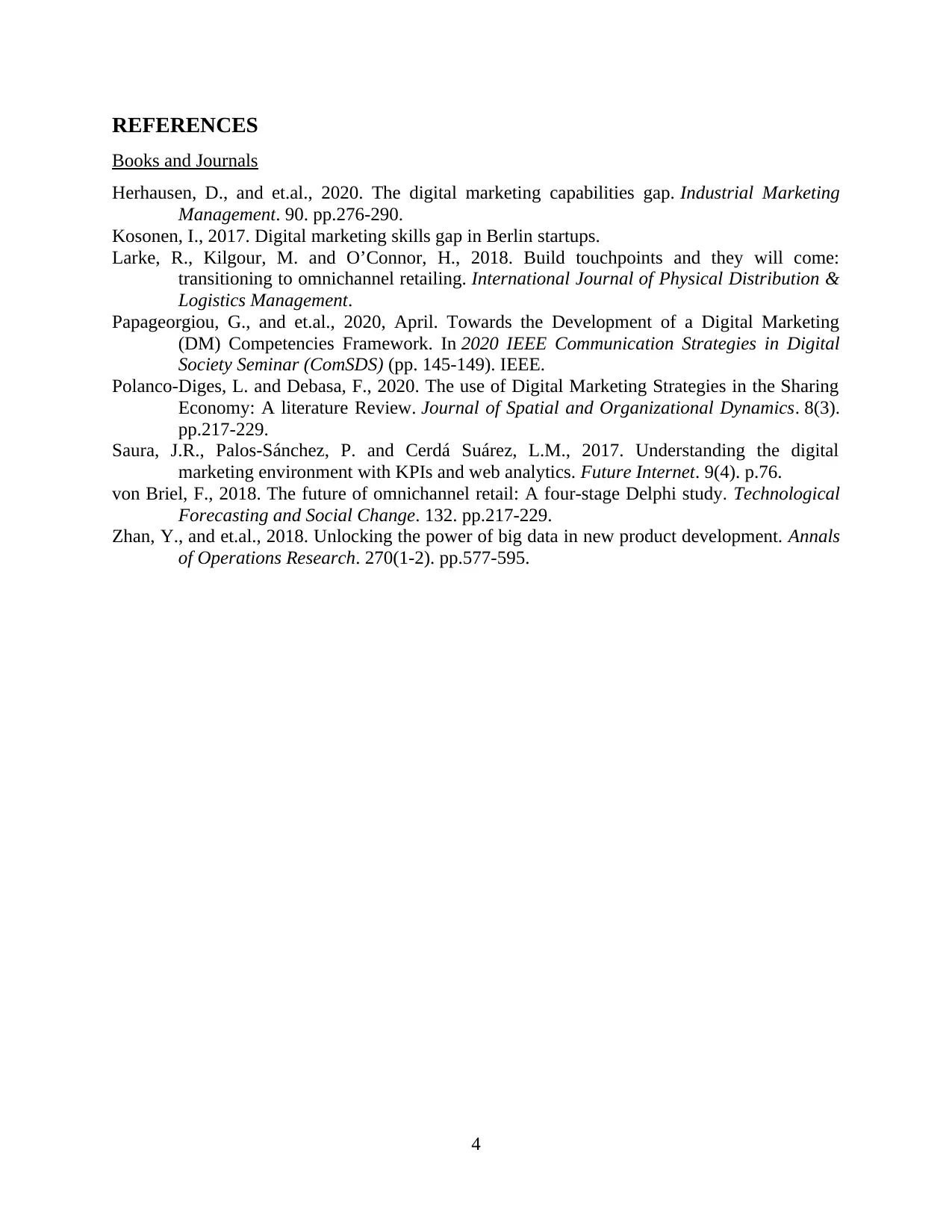
REFERENCES
Books and Journals
Herhausen, D., and et.al., 2020. The digital marketing capabilities gap. Industrial Marketing
Management. 90. pp.276-290.
Kosonen, I., 2017. Digital marketing skills gap in Berlin startups.
Larke, R., Kilgour, M. and O’Connor, H., 2018. Build touchpoints and they will come:
transitioning to omnichannel retailing. International Journal of Physical Distribution &
Logistics Management.
Papageorgiou, G., and et.al., 2020, April. Towards the Development of a Digital Marketing
(DM) Competencies Framework. In 2020 IEEE Communication Strategies in Digital
Society Seminar (ComSDS) (pp. 145-149). IEEE.
Polanco-Diges, L. and Debasa, F., 2020. The use of Digital Marketing Strategies in the Sharing
Economy: A literature Review. Journal of Spatial and Organizational Dynamics. 8(3).
pp.217-229.
Saura, J.R., Palos-Sánchez, P. and Cerdá Suárez, L.M., 2017. Understanding the digital
marketing environment with KPIs and web analytics. Future Internet. 9(4). p.76.
von Briel, F., 2018. The future of omnichannel retail: A four-stage Delphi study. Technological
Forecasting and Social Change. 132. pp.217-229.
Zhan, Y., and et.al., 2018. Unlocking the power of big data in new product development. Annals
of Operations Research. 270(1-2). pp.577-595.
4
Books and Journals
Herhausen, D., and et.al., 2020. The digital marketing capabilities gap. Industrial Marketing
Management. 90. pp.276-290.
Kosonen, I., 2017. Digital marketing skills gap in Berlin startups.
Larke, R., Kilgour, M. and O’Connor, H., 2018. Build touchpoints and they will come:
transitioning to omnichannel retailing. International Journal of Physical Distribution &
Logistics Management.
Papageorgiou, G., and et.al., 2020, April. Towards the Development of a Digital Marketing
(DM) Competencies Framework. In 2020 IEEE Communication Strategies in Digital
Society Seminar (ComSDS) (pp. 145-149). IEEE.
Polanco-Diges, L. and Debasa, F., 2020. The use of Digital Marketing Strategies in the Sharing
Economy: A literature Review. Journal of Spatial and Organizational Dynamics. 8(3).
pp.217-229.
Saura, J.R., Palos-Sánchez, P. and Cerdá Suárez, L.M., 2017. Understanding the digital
marketing environment with KPIs and web analytics. Future Internet. 9(4). p.76.
von Briel, F., 2018. The future of omnichannel retail: A four-stage Delphi study. Technological
Forecasting and Social Change. 132. pp.217-229.
Zhan, Y., and et.al., 2018. Unlocking the power of big data in new product development. Annals
of Operations Research. 270(1-2). pp.577-595.
4
⊘ This is a preview!⊘
Do you want full access?
Subscribe today to unlock all pages.

Trusted by 1+ million students worldwide
1 out of 6
Related Documents
Your All-in-One AI-Powered Toolkit for Academic Success.
+13062052269
info@desklib.com
Available 24*7 on WhatsApp / Email
![[object Object]](/_next/static/media/star-bottom.7253800d.svg)
Unlock your academic potential
Copyright © 2020–2025 A2Z Services. All Rights Reserved. Developed and managed by ZUCOL.





